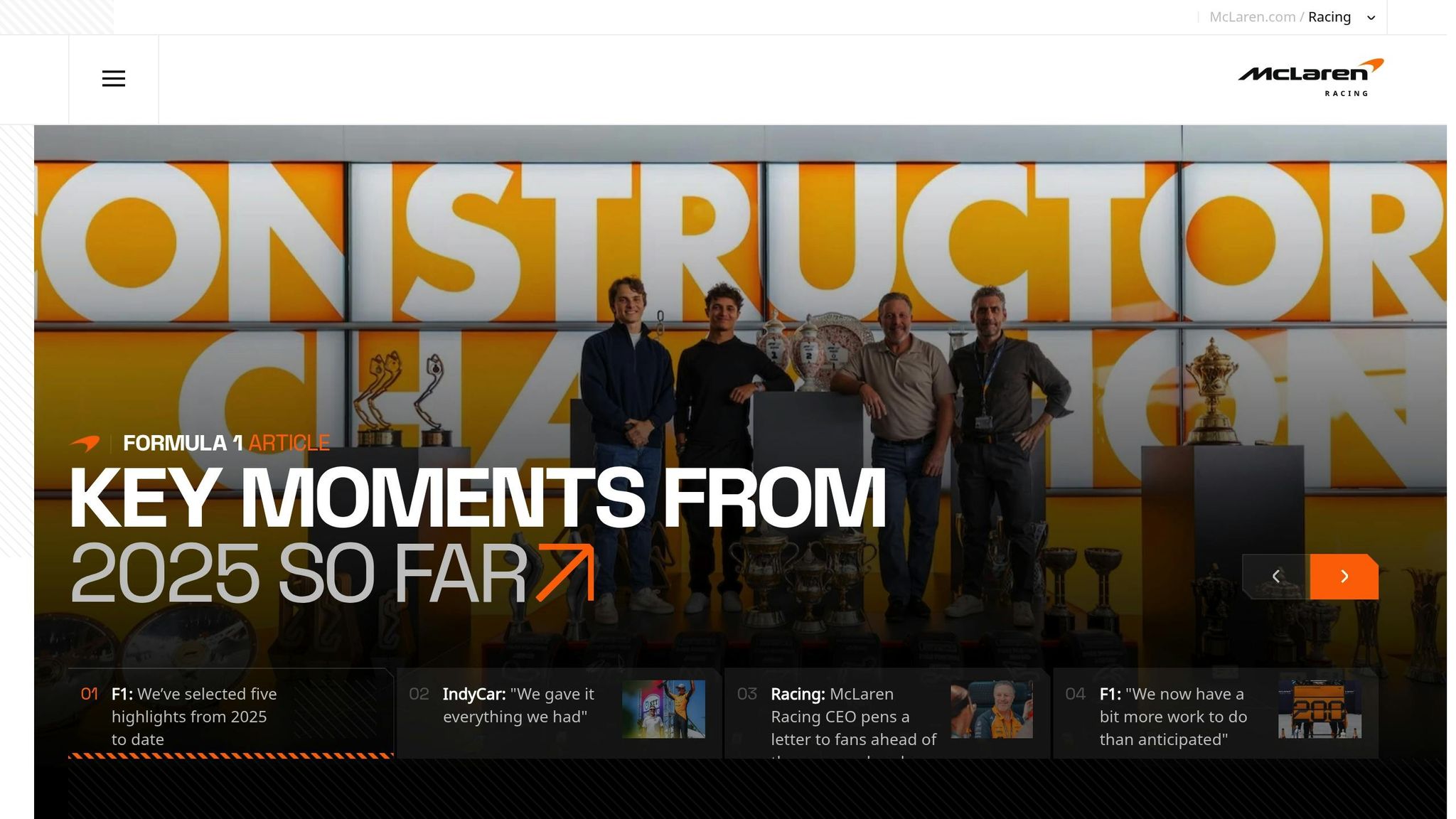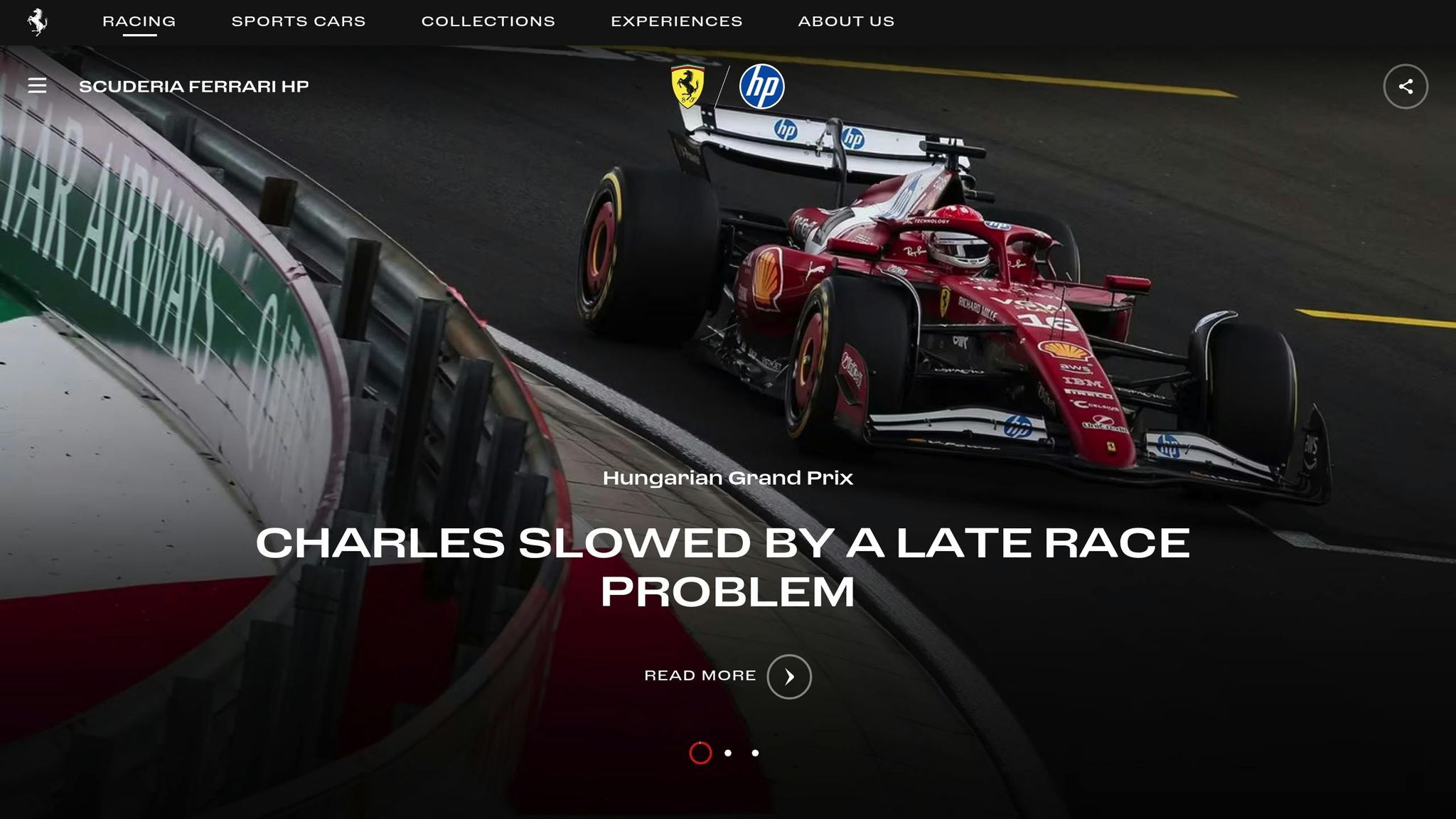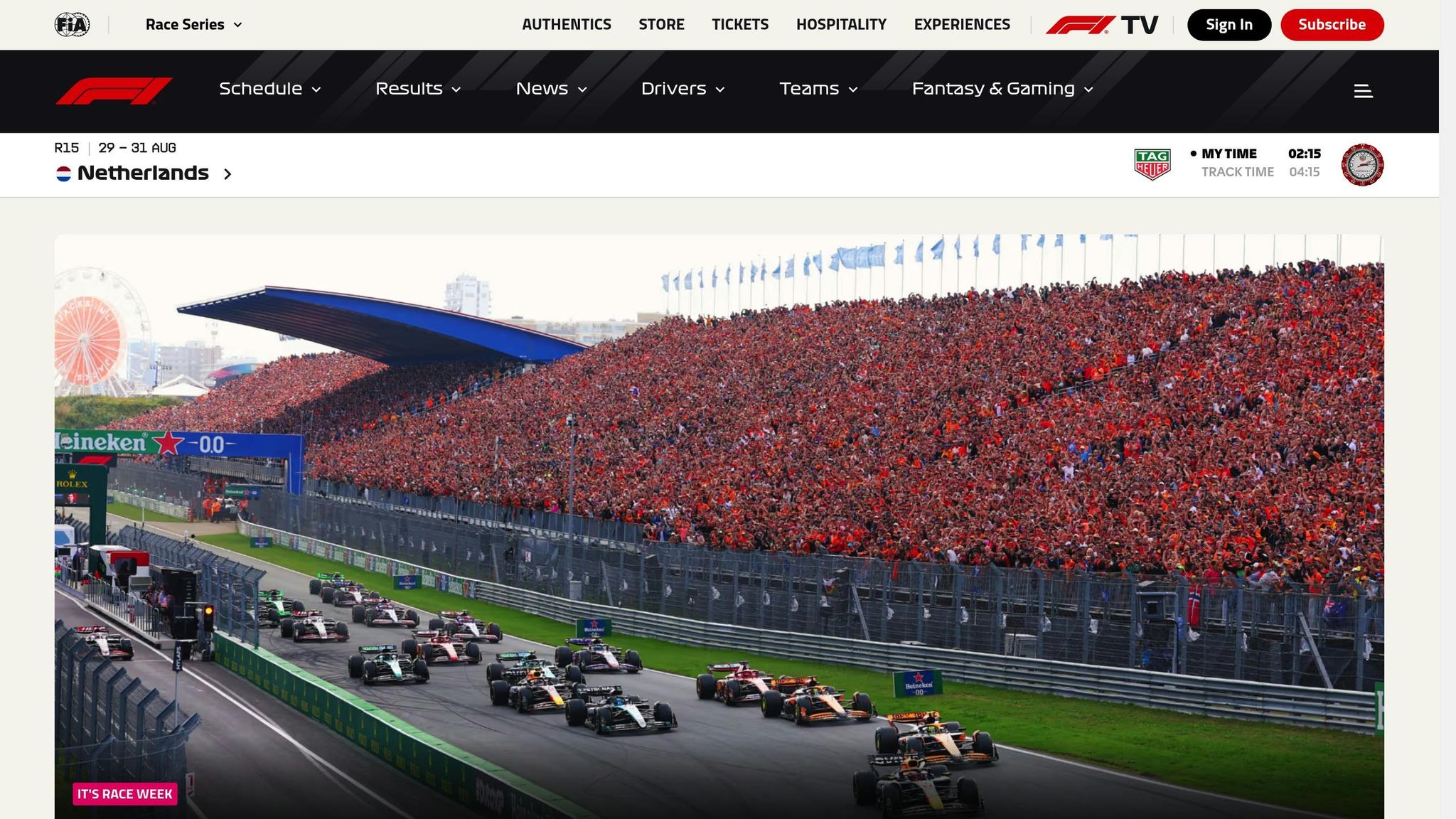Hamilton vs. Alonso: Team Impacts After Exits
Explore how the exits of two star drivers reshaped their teams, revealing deep-rooted challenges and the need for structural changes in Formula 1.

When Lewis Hamilton left McLaren and Fernando Alonso parted ways with Ferrari, both teams faced major challenges. These exits exposed weaknesses in car development, team morale, and overall performance. McLaren struggled with technical issues and a lack of consistency, while Ferrari faced management instability and poor race strategies. Over time, McLaren rebuilt with a focus on system-wide improvements, while Ferrari's traditional approach often clashed with modern racing demands.
Key takeaways:
- Hamilton's departure revealed McLaren's reliance on his talent, leading to a period of decline before a gradual recovery.
- Alonso's exit highlighted Ferrari's internal inefficiencies, which continued to hinder their progress.
- Both teams learned that long-term success requires addressing structural issues, not just replacing star drivers.
Quick Comparison:
| Aspect | McLaren After Hamilton | Ferrari After Alonso |
|---|---|---|
| Initial Challenges | Technical setbacks, poor results | Management instability, strategy errors |
| Recovery Approach | Focused on system improvements | Struggled to modernize processes |
| Key Drivers Post-Exit | Lando Norris, Oscar Piastri | Charles Leclerc, veteran drivers |
| Long-Term Impact | Steady climb back to competitiveness | Continued inconsistency |
Hamilton and Alonso's exits reshaped how teams approach talent and rebuild after losing star drivers. Their stories underline the importance of addressing deeper problems for lasting success.
McLaren After Hamilton: Crisis to Recovery

Performance Drop After Hamilton Left
When Lewis Hamilton parted ways with McLaren, the team faced an undeniable slump in performance. His departure left a void, particularly in technical feedback, which soon revealed flaws in the MP4-28's design. Despite the efforts of Jenson Button and Sergio Pérez, the car's aerodynamic shortcomings and chassis issues became glaringly apparent. This performance decline forced McLaren to reevaluate its approach and make swift strategic adjustments.
New Strategy and Driver Changes
To address these struggles, McLaren embarked on a significant restructuring effort. A major step was ending their long-standing engine partnership before the 2015 season in a bid to regain their competitive edge. Adding to this, McLaren made waves by signing Fernando Alonso from Ferrari, a move that underscored their intent to fight for championships. However, the new engine partnership came with its own set of challenges, particularly reliability issues, which demanded further technical recalibrations. These changes marked the beginning of a tough recovery journey.
Recovery Efforts
The road back to competitiveness was anything but smooth. The initial seasons post-Hamilton were riddled with technical setbacks and scarce podium finishes, largely due to ongoing engine troubles. A turning point came when McLaren opted for a more reliable engine supplier and began refining their chassis design. The introduction of young, dynamic drivers like Lando Norris and Daniel Ricciardo injected fresh energy into the team. A major highlight came in 2021 with a victory at the Italian Grand Prix, breaking a long winless streak. From there, McLaren focused on consistent investments in upgraded facilities, technical expertise, and a sharper development strategy, steadily reestablishing themselves as a team capable of scoring points and competing at a high level.
Ferrari After Alonso: Finding Stability

Ferrari’s journey after Fernando Alonso’s departure mirrors the challenges McLaren faced post-Hamilton, highlighting just how much a star driver can influence a team’s trajectory.
Performance Issues and Management Changes
When Alonso left, Ferrari entered a turbulent phase defined by management shake-ups and struggles with car development. Leadership changes and shifting strategies disrupted the team’s rhythm, leading to noticeable dips in performance on the track.
New Driver Impact
In the wake of Alonso’s exit, Ferrari brought in a seasoned driver whose technical expertise helped steer the team in the right direction. Alongside this veteran, a talented rookie joined the lineup, injecting fresh energy into the team. Together, they contributed to a period of steady progress, laying the groundwork for further improvements in Ferrari’s technical and strategic efforts.
Technical Changes and Championship Results
With lessons learned from Alonso’s time at the helm, Ferrari took a hard look at its technical strategies. The team invested heavily in upgrading its facilities and refining its car development methods, focusing on narrowing the gap between simulation models and real-world track performance. Though the road was bumpy, these efforts eventually paid off, resulting in a more competitive car and a stronger presence in championship battles.
McLaren vs Ferrari: Team Response Comparison
When star drivers leave, teams often face a crossroads, and Ferrari and McLaren’s reactions to such departures couldn't be more different. Their contrasting approaches to leadership and strategy offer a glimpse into how each team navigated recovery and set their paths forward.
Management Styles and Leadership Changes
Ferrari’s response to Fernando Alonso’s departure was marked by a series of inconsistent strategies and questionable decisions. These issues have repeatedly hindered their championship aspirations. One glaring example came during the 2022 season when strategic blunders reportedly allowed Max Verstappen to erase a 50-point deficit against Charles Leclerc, ultimately clinching the title.
On the other hand, McLaren’s management adjustments following Lewis Hamilton’s exit remain less documented. This lack of transparency makes it harder to directly compare the leadership changes between the two teams. However, the noticeable difference in how each team handled transitions suggests divergent philosophies at play.
Technical Development and Car Performance
Ferrari invested heavily in upgrading its facilities and refining its car development processes in an attempt to rebuild. Yet, these technical strides were often undermined by poor race-day strategies, which repeatedly cost them valuable opportunities. McLaren’s technical evolution, in contrast, is less detailed in public records, leaving a gap in understanding their specific adjustments compared to Ferrari’s more visible efforts.
Ultimately, Ferrari’s struggles with strategy and McLaren’s quieter approach to reform highlight the challenges of rebuilding after losing top-tier drivers. These differing responses have not only shaped their performances on the track but also defined their legacies in Formula 1.
Long-Term Effects of Driver Departures
Expanding on the earlier look at the immediate challenges following driver exits, the long-term effects reveal how these departures reshaped the very essence of the teams involved. When Lewis Hamilton and Fernando Alonso left their respective teams, their absences sparked deep organizational changes that influenced performance strategies across the Formula 1 grid.
Team Identity and Brand Evolution
After Lewis Hamilton's departure, McLaren had to confront some hard truths. They could no longer depend on a star driver's sheer talent to mask deeper issues within the organization. This realization marked a turning point, as the team shifted its identity from being heavily reliant on standout drivers to prioritizing system-wide excellence. The transformation wasn’t smooth or quick, but it laid the groundwork for a more stable and consistent future.
This shift led McLaren to make significant investments in infrastructure and technology. The team moved away from the nostalgic belief in "McLaren magic" - a notion tied to their earlier successes - and embraced a data-driven approach to decision-making. By focusing on operational consistency rather than relying on drivers to compensate for strategic or technical gaps, McLaren began building a stronger, more sustainable foundation.
Ferrari’s experience after Fernando Alonso’s exit painted a different picture. The team’s identity remained deeply intertwined with its celebrated history and emotional passion for racing. However, this traditional approach often clashed with the precision and efficiency demanded by modern Formula 1. Ferrari found itself struggling to reconcile its storied legacy with the need for a more calculated, methodical approach to compete with powerhouses like Mercedes and Red Bull.
The Scuderia’s attempts to modernize while preserving its mystique led to a complex brand evolution. This internal conflict often surfaced in inconsistent strategies and management decisions, which hindered their performance throughout the 2010s and into the 2020s. These challenges highlight the importance of aligning a team’s identity with the realities of contemporary racing.
Lessons in Team Building for Formula 1

The contrasting paths of McLaren and Ferrari offer valuable takeaways for Formula 1 teams navigating similar transitions. One key insight is the importance of organizational resilience in adapting to the loss of star drivers.
McLaren’s eventual recovery shows the value of confronting reality and committing to a long-term rebuilding process. By overhauling their technical operations, strategic planning, and talent development programs, they created a foundation that enabled their resurgence. Their success with drivers like Lando Norris and Oscar Piastri is a testament to this renewed focus on nurturing talent within a supportive structure.
On the other hand, Ferrari’s ongoing struggles illustrate the risks of internal stagnation. Despite their vast resources and iconic status, the team’s inability to maintain consistent processes and strategic discipline repeatedly undermined their efforts. Their experience underscores that talent and funding alone cannot fix deeper cultural and organizational flaws.
Succession planning also plays a critical role in weathering such transitions. Teams with robust internal systems and a focus on developing talent are better equipped to adapt. McLaren’s recent successes highlight the benefits of building a culture that supports growth from within, rather than relying solely on external solutions.
Ultimately, both teams learned that achieving lasting change requires leadership to commit to a long-term vision. Quick fixes or reshuffling personnel won’t solve systemic problems. The most successful teams are those willing to challenge their core assumptions and rebuild from the ground up when needed.
The departures of Hamilton and Alonso didn’t just reshape their respective teams - they acted as wake-up calls for the entire Formula 1 landscape. They underscored a shift in focus from individual brilliance to organizational strength, prompting teams across the grid to rethink how they manage talent, plan strategically, and evolve as institutions.
Conclusion: Key Findings from Driver Exits
The departures of Hamilton and Alonso brought to light the strengths and weaknesses within their respective teams, offering a revealing look at how Formula 1 organizations handle the loss of their star drivers.
McLaren’s story following Hamilton’s exit is a compelling example of how short-term setbacks can pave the way for long-term progress. By addressing deeper structural issues rather than relying solely on driver talent, the team laid a stronger foundation. Today, with drivers like Lando Norris and Oscar Piastri, McLaren’s resurgence shows that prioritizing systematic improvements pays off over time.
Ferrari’s experience, on the other hand, highlights the risks of failing to evolve. Despite their immense resources and iconic status, the team struggled to modernize while staying true to their identity. This inability to adapt has led to ongoing instability, proving that even the most storied teams can falter without meaningful internal change.
These contrasting approaches reveal a critical takeaway: losing a star driver can ignite necessary transformation. Teams that embrace this disruption as an opportunity to rebuild often emerge stronger, while those that resist change risk stagnation. McLaren’s steady climb back to competitiveness versus Ferrari’s continued inconsistency underscores this point.
The Formula 1 landscape has shifted, with teams now focusing more on organizational resilience than relying on individual brilliance. This change has driven advancements in succession planning, technical innovation, and internal team culture, making the grid more competitive overall.
For teams navigating similar challenges, the Hamilton and Alonso departures offer a clear lesson: face the reality of change, commit to long-term rebuilding instead of quick fixes, and prioritize building a strong system over depending on star power. Those who follow this approach are better positioned to achieve lasting success in Formula 1’s ever-changing environment.
FAQs
How did McLaren adapt and recover after Lewis Hamilton left the team?
After Lewis Hamilton's departure, McLaren shifted gears and revamped their strategy, emphasizing adaptable race plans and sharpening their technological capabilities. One standout tactic they embraced was using split strategies, allowing them to adjust to unpredictable race conditions and squeeze the most out of every opportunity on the track.
Their comeback was fueled by several key changes: improved tire management, significant investments in aerodynamic advancements, and a renewed focus on team flexibility. These efforts played a crucial role in helping McLaren climb back into the competitive mix and reclaim their position as a formidable force in Formula 1.
What challenges did Ferrari face after Fernando Alonso left, and how have they worked to overcome them?
When Fernando Alonso parted ways with Ferrari, the team found itself grappling with some serious hurdles, particularly in terms of strategic consistency and reliability. Alonso had frequently voiced concerns about Ferrari's erratic strategy calls, and his departure seemed to shine an even brighter spotlight on these shortcomings. Adding to the challenge were internal conflicts and the absence of a unified, forward-looking plan, both of which made it tough for the team to maintain a steady presence at the top.
In response, Ferrari has taken significant steps to tackle these issues head-on. They’ve worked on fine-tuning their race strategies, ensuring smoother communication on the pit wall, and pouring resources into advanced technology to boost car performance. These measures are all part of Ferrari’s mission to reclaim their competitive edge and establish a more dependable approach, both on the track and behind the scenes.
How did Hamilton and Alonso’s departures expose key structural challenges within their F1 teams?
The departures of Lewis Hamilton and Fernando Alonso brought to light some key weaknesses within their respective Formula 1 teams, particularly an overdependence on star drivers and a lack of internal stability. Hamilton’s decision to leave McLaren and Alonso’s frequent team changes exposed how difficult it can be for organizations to sustain high performance when top-tier talent moves on.
These high-profile exits underline the need for teams to create robust structures, prioritize long-term planning, and invest in technical advancements. Without addressing these critical areas, teams risk falling behind, proving that success in Formula 1 requires much more than the brilliance of a single driver.




